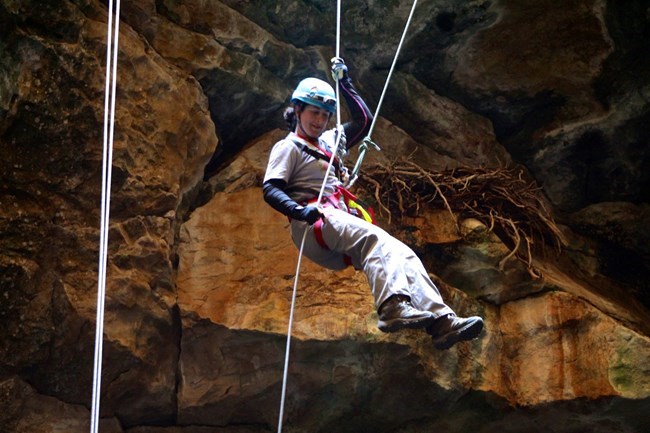Part of a series of articles titled Women's History in the Pacific West - Columbia-Pacific Northwest Collection.
Previous: Ida Blackeagle
Next: Kimiko Kaye Tambara
Article

Photo by Justin Sipla.
Julie A. Meachen is a pathbreaking vertebrate paleontologist and morphologist who studies mammalian carnivores and megafauna from the late Pleistocene period (10,000 years ago) to the present day. Meachen’s early field work at Hagerman Fossil Beds National Monument increased understanding of the effects of climate change on animal habitat and adaptation. She subsequently went on to excavate fossils in Wyoming, Florida, and California. Her research has shed critical light on climate change, evolutionary biology, and modern-day ecological practices.1
Meachen’s educational pursuits shaped the kind of scientist she became. As a teenager, she was drawn to life science subjects such as biology and anatomy, particularly of large animals. She developed a specific interest in animal skeletons when she volunteered in the University of Florida’s paleontology collection as an undergraduate.2 After earning her undergraduate and Master’s degree at the University of Florida, she pursued a PhD in ecology and evolutionary biology at UCLA and graduated in 2008. She worked as a postdoctoral scholar at the National Evolutionary Synthesis Center in North Carolina, an instructor at Marshall University in West Virginia, and a faculty member at Des Moines University.3 She uses her knowledge of comparative anatomy across multiple species to train future health professionals in human development and genetic diseases.4
Throughout her career, Meachen has participated in remarkable finds. On her first dig at the Haile 7C site in Florida she helped discover a new species of giant ground sloth, which is still the largest giant ground sloth skeleton ever found. As a paleontology intern at Hagerman Fossil Beds, Meachen and her fellow researchers discovered a bear specimen that existed a million years after when that species of bear was thought to have gone extinct in North America. This discovery not only moved that extinction date by a million years, but it also represented the northernmost occurrence of this type of bear in North America, expanding both the territory and the chronology of the bear.5 She also analyzed a fully intact mummified wolf pup found in Canada to discover more about its DNA.6
Meachen studies the vital connection between climate change and animal extinction. Supported by grants from National Geographic and the National Science Foundation, Meachen led excavations at Natural Trap Cave in Wyoming. For over four years, she led a team of researchers and volunteers collecting fossils and ancient DNA of mammals such as horses, coyotes, and wolves. Her work showed how these animals evolved in response to the changing climate and faunal landscape around them. Meachen’s research is essential in linking the lives of animals in the distant past to the ways that modern populations interact with their environment.7
In addition to being a leader in her field, Meachen is a mentor and outreach educator. She has involved groups such as Barefoot (a group that connects children, art, and science) with her fieldwork at Natural Trap Cave.8 As a postdoc, she visited high schools to encourage students to pursue careers in science and became a mentor to undergraduate students in the Society for the Advancement of Chicanos and Native Americans in Science. Since 2014, she has mentored high school students from the Des Moines Central Campus, involving them in her lab and assisting in their own projects.9 As Meachen said, “I would really love to inspire future generations of scientists to carry on important work on climate change and animal/habitat extinctions.”10
The Hagerman Fossil Bed’s robust collection of Pliocene fossils have yielded a wealth of information for Meachen and her fellow scientists working to create a better current natural environment. The impact of Meachen’s work there and at other research sites, as well as her mentorship of aspiring scientists as a professor, will influence the field of paleontology far into the future.
Part of a series of articles titled Women's History in the Pacific West - Columbia-Pacific Northwest Collection.
Previous: Ida Blackeagle
Next: Kimiko Kaye Tambara
Last updated: February 22, 2022